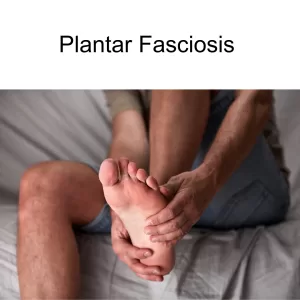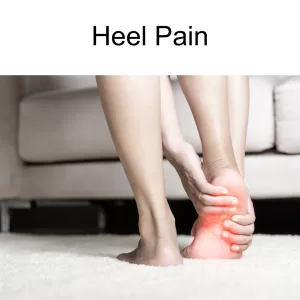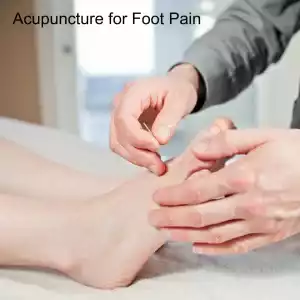By Qineng Tan, L.Ac., Ph.D. and Xiaomei Cai, L.Ac., Ph.D.

Foot arch pain? Ache in the bottom of the foot or heel? This condition has commonly been known as plantar fasciitis, but now more practitioners are calling it “plantar fasciosis.” Acupuncture treatment can help relieve arch and foot pain and get you walking comfortably again.
What Is Plantar Fasciosis?
The plantar fascia ligament connects the heel bone to the toes, spanning the whole bottom of the foot. It absorbs shock every time your foot touches the ground, as you walk.
When this band of connective tissue starts to cause you pain, it’s usually due to overuse, overstretching, or wearing shoes that don’t give you enough support and cushioning.
This condition, which is the most common cause of heel pain and pain in the bottom of the foot, has been called “plantar fasciitis” for some time, because it was believed to be caused by inflammation in the connective tissue. The suffix “-itis” means “inflammation,” as in “tendinitis,” “pancreatitis,” and many other health conditions that are related to inflamed tissues.
If the bottom of the foot shows signs of swelling, warmth, and redness, then it is probably related to inflammation.
However, many cases of plantar fascia pain are not caused by inflammation. Sometimes, arch pain is due to a degenerative condition, in which the tissues are breaking down. Microtears in the connective tissues, or cell death, because of lack of blood flow, are often the real problems causing the pain.
Symptoms of Plantar Fasciosis
Arch and foot pain when you first get up in the morning is one of the most common signs of plantar fasciitis or plantar fasciosis. This pain can be sharp and stabbing, or more of a dull ache.
Often, walking or exercise makes the foot feel better for a while, but then, after you sit down and rest, and then get back up, the pain flares up again.
The signs that you may have damage in your plantar fascia include:
- Pain in the heel of your foot
- Sore foot arch or foot arch tenderness
- Stiffness in the foot
- Tight Achilles tendon
- Swelling around the heel
Why Does the Bottom of My Foot Hurt?

Lots of activities can cause damage to the sensitive connective tissue in the bottom of your foot. Some of the causes of plantar fasciosis include:
- Standing for long periods of time
- Working out, dancing, or just walking on a hard surface (like a concrete floor or sidewalk)
- Exercising without stretching or warming up your feet and leg muscles
- Wearing shoes with little support, like sandals or flat sneakers
- Walking around barefoot a lot (even at home)
You might be more susceptible if your arches are very high, or if your feet don’t have much of an arch at all. You may also be at higher risk for foot pain if you are carrying a lot of extra weight.
Conditions like rheumatoid arthritis or psoriatic arthritis can also contribute to the development of plantar fasciosis.
Plantar Fasciosis Treatment
Typically, a doctor does not even need to perform any special diagnostic testing to conclude that a person is experiencing plantar fasciitis, or “heel spur syndrome.”
A treatment protocol typically includes some stretching exercises, the use of orthotics, OTC pain medications, and possibly corticosteroid injections.
Rest and patience, and a gradual increase of physical activity are usually recommended.
Acupuncture treatment can help by relieving pain and helping to promote healing in the damaged tissues.
Can Acupuncture Help Plantar Fasciosis/Plantar Fasciitis?

TCM takes a holistic approach to treating pain conditions and sports injuries. From the TCM perspective, trauma to the plantar fascia area can lead to stagnation and deficiency in the flow of Qi and blood.
Acupuncture, Tuina massage, and gua sha are all TCM modalities that can help improve blood flow and promote healing.
Pain sensations stem from injury and damage to bodily tissues, but the pain signals themselves are controlled by the central nervous system and brain activity. Acupuncture has been shown to have effects that can calm down this signalling, which can alter how a person experiences feelings of pain.
Medical science is still conducting research to understand how it is that acupuncture treatment works effectively to reduce and relieve pain.
The action and “excitability” of neurons in the hypothalamus are related to pain sensations. It has been suggested that acupuncture treatment may help to change the excitability of the neurons, thus changing the perception of pain.
It has also been suggested that pain in the plantar fascia is related to the activation of trigger points in the muscles of the foot. Electro-acupuncture can help “deactivate” these trigger points to relieve pain.
Acupuncture needling may affect nerve endings in the local area that release vasoactive neuropeptides, which play a key role in blood flow to an area and the release of hormones. It may also reduce electrical activity, or the “twitch” response in muscle tissues.
Acupuncture can also increase the levels of endorphins, serotonin, and noradrenaline released by the body’s own pain relief system, and help to decrease the number of pain signals that are being sent through the central nervous system.
One study compared patients who were given exercises to help with their plantar fasciopathy versus patients who did the exercises and were given acupuncture treatment. The exercise-only group experienced an overall 21% reduction of their pain scores, while the acupuncture group reported a greater than 50% reduction in pain right after the treatments.
How to Help Plantar Fasciosis Pain
Here are a few important tip for how to help heal and prevent foot pain from coming back.
- Wear shoes with a wide toe box and flat heels (not high heels). Be sure to replace your shoes as needed; the cushioning foam in shoes breaks down, even if you haven’t been wearing them often.
- Wearing toe spacers that help create more space around your toes can help by reducing the constriction of blood vessels and getting more blood flow to your whole foot.
- A warm foot bath every night before bedtime, especially with Chinese herbs or Epsom salt, is very helpful for circulation, which is essential for healing damaged connective tissue.
- Warm up properly before your workout, and vary your workouts, so that you are not just engaging in the same repetitive actions every time you exercise.
- Avoid running and walking on concrete surfaces, and avoid exercising outdoors when it is damp, rainy, and cold.
Acupuncture Near Me for Plantar Fasciosis in West Los Angeles
Plantar fasciosis pain can get in the way of your daily exercise routine and make walking painful for months, if you don’t take proper care of it. The right combination of gentle exercise, acupuncture treatment, herbs and nutrition can help you get back to walking normally without pain more quickly. If you are feeling that pain in the bottom of your foot every morning when you get out of bed, please consider coming and seeing Dr. Tan or Dr. Cai to help relieve heel pain.
*This article is for education from the perspective of Traditional Chinese Medicine only. The education provided by this article is not approved by FDA to diagnose, prevent, treat and cure human diseases. It should not stop you from consulting with your physician for your medical conditions. Traditional Chinese Medicine is based on Qi, which is an invisible force that usually cannot be observed by modern science. Because science focuses on testing ideas about the natural world with evidence obtained through observation, these aspects of acupuncture can’t be studied by science. Therefore acupuncture and Chinese herbs are often not supported by double-blind, randomized trials, and they are considered alternative medicine therapies in the United States.
